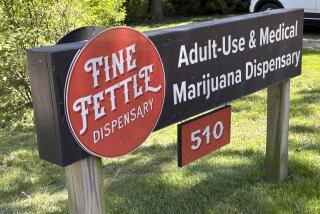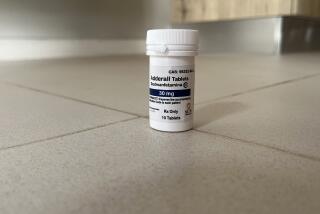Cocaine Supply Dwindles--First Time in Decade
- Share via
WASHINGTON — The Drug Enforcement Administration declared Tuesday that significant shortages in wholesale cocaine supplies are emerging across the United States in the first such reversal since epidemic use of the drug began a decade ago.
In an important note of endorsement, the DEA conclusion was supported by local law enforcement officials in Los Angeles and around the country. Many of those officials in the past have been skeptical of federal claims of progress in the drug war.
“The drug product is being taken off the street and the pricing has gone up,” said Lt. David Marsden, commander of narcotics for the police department in Torrance. “I think we have the drug dealers on the run.”
The DEA report to the Senate Judiciary Committee provided the first detailed federal explanation for data from across the United States showing that prices dealers are paying for cocaine have surged in recent months. When declining purity is taken into account, the price of pure cocaine has surged an estimated 88% in Los Angeles since last December, DEA officials said after the hearing.
The drug agency cautioned that large quantities of cocaine probably remain stockpiled in South America and it noted that the drug still is readily available for purchase in most American cities, though often in diluted form.
But in formal testimony by a high-ranking official, the DEA cast aside its past reluctance to draw conclusions from the trends and said that it is now certain that an intensified law enforcement crackdown in South America has disrupted cocaine shipments and left American markets in short supply.
“This is really the first dip we’ve seen since the epidemic began,” said Ronald Caffrey, a DEA deputy assistant administrator.
The chairman of the Senate panel, Sen. Joseph R. Biden Jr. (D-Del.), immediately hailed the report as “good news” and a long-awaited sign that the United States had begun to make inroads against the cocaine supply.
And in Los Angeles, police department spokesman Cmdr. William Booth said that the same shortages that have sent wholesale prices soaring have now forced some dealers to switch from peddling cocaine back to selling marijuana.
But officials from both political parties and all levels of law enforcement tempered their comments with warnings against excess optimism, saying that the new findings demonstrate the need to keep up the pressure on drug trafficking.
“We should have more disruption, more pressure,” William J. Bennett, director of the White House Office of Drug Control Policy, said in an interview. “If this is a response to our putting the heat on, then let’s turn up the thermostat.”
Added Biden, considered a leading Democratic spokesman on drug issues: “We still have a long, long, long way to go.”
The new indications of a cocaine shortage reflect a dramatic shift in the U.S. market for the drug. In the last three months, wholesale cocaine prices in major American cities have spiraled upward while average purity of the drug has spiraled downward.
The resulting diminution in the purity of cocaine--from an average 66% to 55% since the end of the year--is expected to have an accelerating effect on what was already a significant decline in cocaine-related medical emergencies in the United States, officials said.
Besides the 88% increase in Los Angeles since December, the combined effect of the price boom and quality plunge has meant that the real cost of pure cocaine at wholesale has jumped by an estimated 67% in Houston, 64% in New York City, 50% in Chicago and 23% in Miami.
The percentage increases were calculated by adjusting the average wholesale price of a kilogram of diluted cocaine to reflect the price actually paid for the pure drug it contains. The adjusted percentages are higher because the purity has been declining at the same time that the price of the diluted product has been increasing.
Even the average price for the increasingly diluted product has jumped across the board, increasing to $32,000 per kilogram from $25,000 in Chicago, for example.
The drug agency did not provide detailed statistics from 19 other U.S. cities surveyed by its officials in recent weeks. But Caffrey said that the agency is now confident that shortages of the drug had emerged at the wholesale level “almost nationwide.”
Law enforcement officials in Chicago and Houston echoed that assessment, saying that sharp price increases in their cities, coupled with accounts provided by confidential informants, have convinced them that incoming cocaine shipments have become increasingly scarce.
And in Miami, James Hall, director of the Up Front Drug Information Center and a member of an advisory panel for the National Institute of Drug Abuse, said it is clear that there has been a “dramatic escalation” of wholesale cocaine prices in most American cities.
The shortage in the wholesale market is regarded as particularly significant because it is the area most likely to reflect disruption in the pipeline that delivers cocaine from South American manufacturers to distributors in the United States.
Caffrey, the senior DEA official, acknowledged in his testimony that there are some indications that the shortage has resulted from a calculated decision by traffickers to stockpile cocaine in safe havens outside the United States in hopes of forcing prices up.
But he said other evidence points to the role played by the law enforcement crackdown, which in recent months has resulted in record cocaine seizures in Mexico and Colombia and targeted millions of dollars in U.S. funds to stepped-up efforts to intercept drug shipments.
As a result, Caffrey and other federal drug experts said, drug traffickers may have been unable to deliver sufficient supplies of cocaine to the United States or been forced to postpone some shipments in hopes of rerouting them along more secure supply lines.
“I think they have to work a little harder in their minds to get it through the lines,” the DEA official said.
The disruption in the wholesale market has not emerged in an obvious fashion on the street, where law enforcement officials across the country said that one-gram quantities of cocaine still are available at prices that have remained constant for months.
But federal officials said their new findings show that those one-gram quantities are considerably less pure than they were six months ago.
Staff writer Ron Smith in Los Angeles contributed to this story.
More to Read
Sign up for Essential California
The most important California stories and recommendations in your inbox every morning.
You may occasionally receive promotional content from the Los Angeles Times.










